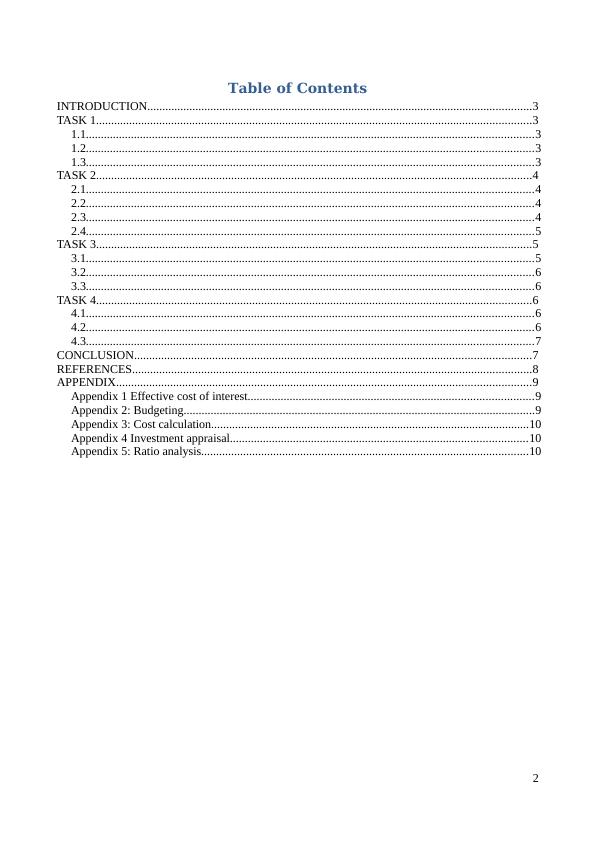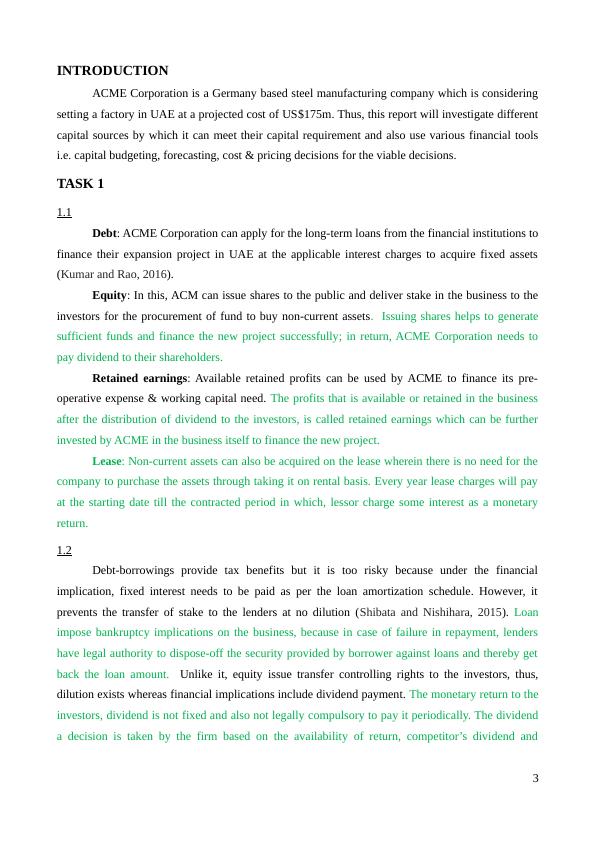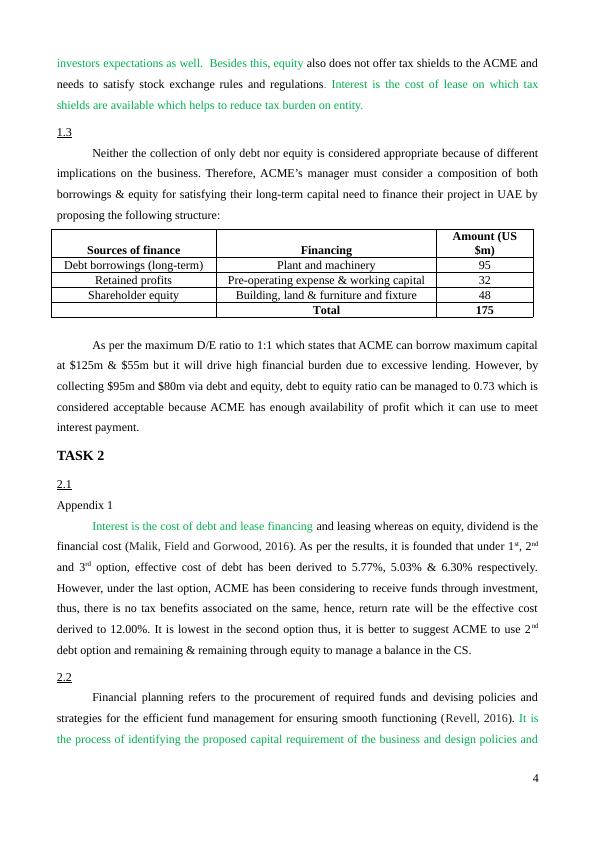Managing Financial Resources & Decisions: Doc
Added on 2019-12-18
13 Pages3813 Words34 Views
Managing Financial
Resources & decisions
1
Resources & decisions
1

Table of Contents
INTRODUCTION................................................................................................................................3
TASK 1.................................................................................................................................................3
1.1.....................................................................................................................................................3
1.2.....................................................................................................................................................3
1.3.....................................................................................................................................................3
TASK 2.................................................................................................................................................4
2.1.....................................................................................................................................................4
2.2.....................................................................................................................................................4
2.3.....................................................................................................................................................4
2.4.....................................................................................................................................................5
TASK 3.................................................................................................................................................5
3.1.....................................................................................................................................................5
3.2.....................................................................................................................................................6
3.3.....................................................................................................................................................6
TASK 4.................................................................................................................................................6
4.1.....................................................................................................................................................6
4.2.....................................................................................................................................................6
4.3.....................................................................................................................................................7
CONCLUSION....................................................................................................................................7
REFERENCES.....................................................................................................................................8
APPENDIX..........................................................................................................................................9
Appendix 1 Effective cost of interest...............................................................................................9
Appendix 2: Budgeting.....................................................................................................................9
Appendix 3: Cost calculation..........................................................................................................10
Appendix 4 Investment appraisal...................................................................................................10
Appendix 5: Ratio analysis.............................................................................................................10
2
INTRODUCTION................................................................................................................................3
TASK 1.................................................................................................................................................3
1.1.....................................................................................................................................................3
1.2.....................................................................................................................................................3
1.3.....................................................................................................................................................3
TASK 2.................................................................................................................................................4
2.1.....................................................................................................................................................4
2.2.....................................................................................................................................................4
2.3.....................................................................................................................................................4
2.4.....................................................................................................................................................5
TASK 3.................................................................................................................................................5
3.1.....................................................................................................................................................5
3.2.....................................................................................................................................................6
3.3.....................................................................................................................................................6
TASK 4.................................................................................................................................................6
4.1.....................................................................................................................................................6
4.2.....................................................................................................................................................6
4.3.....................................................................................................................................................7
CONCLUSION....................................................................................................................................7
REFERENCES.....................................................................................................................................8
APPENDIX..........................................................................................................................................9
Appendix 1 Effective cost of interest...............................................................................................9
Appendix 2: Budgeting.....................................................................................................................9
Appendix 3: Cost calculation..........................................................................................................10
Appendix 4 Investment appraisal...................................................................................................10
Appendix 5: Ratio analysis.............................................................................................................10
2

INTRODUCTION
ACME Corporation is a Germany based steel manufacturing company which is considering
setting a factory in UAE at a projected cost of US$175m. Thus, this report will investigate different
capital sources by which it can meet their capital requirement and also use various financial tools
i.e. capital budgeting, forecasting, cost & pricing decisions for the viable decisions.
TASK 1
1.1
Debt: ACME Corporation can apply for the long-term loans from the financial institutions to
finance their expansion project in UAE at the applicable interest charges to acquire fixed assets
(Kumar and Rao, 2016).
Equity: In this, ACM can issue shares to the public and deliver stake in the business to the
investors for the procurement of fund to buy non-current assets. Issuing shares helps to generate
sufficient funds and finance the new project successfully; in return, ACME Corporation needs to
pay dividend to their shareholders.
Retained earnings: Available retained profits can be used by ACME to finance its pre-
operative expense & working capital need. The profits that is available or retained in the business
after the distribution of dividend to the investors, is called retained earnings which can be further
invested by ACME in the business itself to finance the new project.
Lease: Non-current assets can also be acquired on the lease wherein there is no need for the
company to purchase the assets through taking it on rental basis. Every year lease charges will pay
at the starting date till the contracted period in which, lessor charge some interest as a monetary
return.
1.2
Debt-borrowings provide tax benefits but it is too risky because under the financial
implication, fixed interest needs to be paid as per the loan amortization schedule. However, it
prevents the transfer of stake to the lenders at no dilution (Shibata and Nishihara, 2015). Loan
impose bankruptcy implications on the business, because in case of failure in repayment, lenders
have legal authority to dispose-off the security provided by borrower against loans and thereby get
back the loan amount. Unlike it, equity issue transfer controlling rights to the investors, thus,
dilution exists whereas financial implications include dividend payment. The monetary return to the
investors, dividend is not fixed and also not legally compulsory to pay it periodically. The dividend
a decision is taken by the firm based on the availability of return, competitor’s dividend and
3
ACME Corporation is a Germany based steel manufacturing company which is considering
setting a factory in UAE at a projected cost of US$175m. Thus, this report will investigate different
capital sources by which it can meet their capital requirement and also use various financial tools
i.e. capital budgeting, forecasting, cost & pricing decisions for the viable decisions.
TASK 1
1.1
Debt: ACME Corporation can apply for the long-term loans from the financial institutions to
finance their expansion project in UAE at the applicable interest charges to acquire fixed assets
(Kumar and Rao, 2016).
Equity: In this, ACM can issue shares to the public and deliver stake in the business to the
investors for the procurement of fund to buy non-current assets. Issuing shares helps to generate
sufficient funds and finance the new project successfully; in return, ACME Corporation needs to
pay dividend to their shareholders.
Retained earnings: Available retained profits can be used by ACME to finance its pre-
operative expense & working capital need. The profits that is available or retained in the business
after the distribution of dividend to the investors, is called retained earnings which can be further
invested by ACME in the business itself to finance the new project.
Lease: Non-current assets can also be acquired on the lease wherein there is no need for the
company to purchase the assets through taking it on rental basis. Every year lease charges will pay
at the starting date till the contracted period in which, lessor charge some interest as a monetary
return.
1.2
Debt-borrowings provide tax benefits but it is too risky because under the financial
implication, fixed interest needs to be paid as per the loan amortization schedule. However, it
prevents the transfer of stake to the lenders at no dilution (Shibata and Nishihara, 2015). Loan
impose bankruptcy implications on the business, because in case of failure in repayment, lenders
have legal authority to dispose-off the security provided by borrower against loans and thereby get
back the loan amount. Unlike it, equity issue transfer controlling rights to the investors, thus,
dilution exists whereas financial implications include dividend payment. The monetary return to the
investors, dividend is not fixed and also not legally compulsory to pay it periodically. The dividend
a decision is taken by the firm based on the availability of return, competitor’s dividend and
3

investors expectations as well. Besides this, equity also does not offer tax shields to the ACME and
needs to satisfy stock exchange rules and regulations. Interest is the cost of lease on which tax
shields are available which helps to reduce tax burden on entity.
1.3
Neither the collection of only debt nor equity is considered appropriate because of different
implications on the business. Therefore, ACME’s manager must consider a composition of both
borrowings & equity for satisfying their long-term capital need to finance their project in UAE by
proposing the following structure:
Sources of finance Financing
Amount (US
$m)
Debt borrowings (long-term) Plant and machinery 95
Retained profits Pre-operating expense & working capital 32
Shareholder equity Building, land & furniture and fixture 48
Total 175
As per the maximum D/E ratio to 1:1 which states that ACME can borrow maximum capital
at $125m & $55m but it will drive high financial burden due to excessive lending. However, by
collecting $95m and $80m via debt and equity, debt to equity ratio can be managed to 0.73 which is
considered acceptable because ACME has enough availability of profit which it can use to meet
interest payment.
TASK 2
2.1
Appendix 1
Interest is the cost of debt and lease financing and leasing whereas on equity, dividend is the
financial cost (Malik, Field and Gorwood, 2016). As per the results, it is founded that under 1st, 2nd
and 3rd option, effective cost of debt has been derived to 5.77%, 5.03% & 6.30% respectively.
However, under the last option, ACME has been considering to receive funds through investment,
thus, there is no tax benefits associated on the same, hence, return rate will be the effective cost
derived to 12.00%. It is lowest in the second option thus, it is better to suggest ACME to use 2nd
debt option and remaining & remaining through equity to manage a balance in the CS.
2.2
Financial planning refers to the procurement of required funds and devising policies and
strategies for the efficient fund management for ensuring smooth functioning (Revell, 2016). It is
the process of identifying the proposed capital requirement of the business and design policies and
4
needs to satisfy stock exchange rules and regulations. Interest is the cost of lease on which tax
shields are available which helps to reduce tax burden on entity.
1.3
Neither the collection of only debt nor equity is considered appropriate because of different
implications on the business. Therefore, ACME’s manager must consider a composition of both
borrowings & equity for satisfying their long-term capital need to finance their project in UAE by
proposing the following structure:
Sources of finance Financing
Amount (US
$m)
Debt borrowings (long-term) Plant and machinery 95
Retained profits Pre-operating expense & working capital 32
Shareholder equity Building, land & furniture and fixture 48
Total 175
As per the maximum D/E ratio to 1:1 which states that ACME can borrow maximum capital
at $125m & $55m but it will drive high financial burden due to excessive lending. However, by
collecting $95m and $80m via debt and equity, debt to equity ratio can be managed to 0.73 which is
considered acceptable because ACME has enough availability of profit which it can use to meet
interest payment.
TASK 2
2.1
Appendix 1
Interest is the cost of debt and lease financing and leasing whereas on equity, dividend is the
financial cost (Malik, Field and Gorwood, 2016). As per the results, it is founded that under 1st, 2nd
and 3rd option, effective cost of debt has been derived to 5.77%, 5.03% & 6.30% respectively.
However, under the last option, ACME has been considering to receive funds through investment,
thus, there is no tax benefits associated on the same, hence, return rate will be the effective cost
derived to 12.00%. It is lowest in the second option thus, it is better to suggest ACME to use 2nd
debt option and remaining & remaining through equity to manage a balance in the CS.
2.2
Financial planning refers to the procurement of required funds and devising policies and
strategies for the efficient fund management for ensuring smooth functioning (Revell, 2016). It is
the process of identifying the proposed capital requirement of the business and design policies and
4

End of preview
Want to access all the pages? Upload your documents or become a member.
Related Documents
Types of Financial Sources : Assignmentlg...
|17
|3535
|42
Project - Selection & Consideration Of Sources Of Financelg...
|21
|4660
|89
Capital Structure Theories and Calculation of Cost of Capital for Deskliblg...
|14
|3192
|289
Managing Financial Resources Assignment : R.L. Maynardlg...
|18
|4418
|141
Importance of Source of Finance Report - The City Hotel Plclg...
|17
|3774
|47
Journal of Financial Economicslg...
|6
|1043
|20
